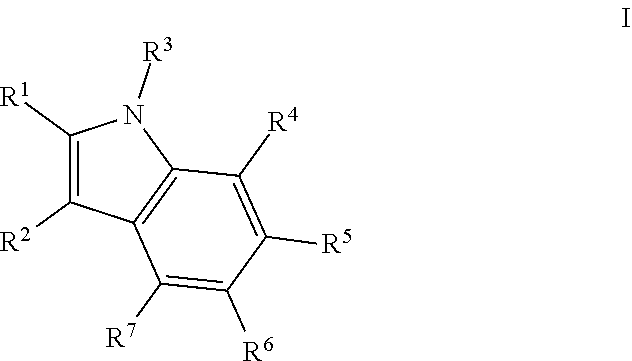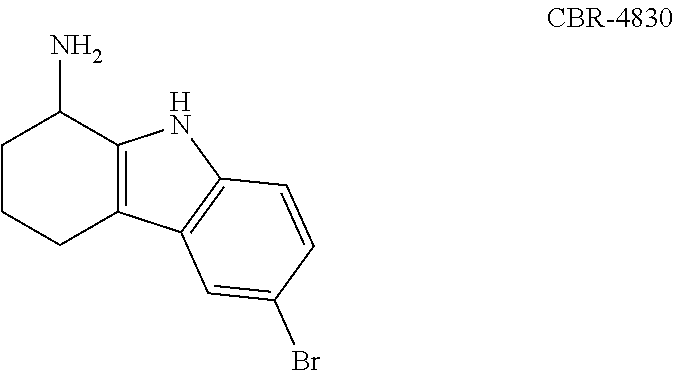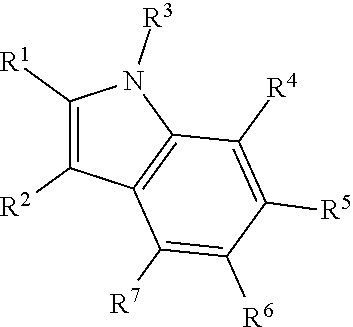Therapeutic compounds and methods to treat infection
a technology applied in the field of therapeutic compounds and methods to treat infections, can solve the problems of increasing morbidity and mortality, threatening the clinical utility of antibacterial therapy, and prolonging patient hospitalization
- Summary
- Abstract
- Description
- Claims
- Application Information
AI Technical Summary
Benefits of technology
Problems solved by technology
Method used
Image
Examples
example 1
on of 1-(5-bromo-1H-indol-2-yl)ethan-1-amine
[0383]
1-(5-Bromo-1H-indol-2-yl)ethan-1-amine
[0384]1-(5-Bromo-1H-indol-2-yl)ethan-1-one (95 mg, 0.40 mmol), ammonium acetate (308 mg, 4.00 mmol) and sodium cyanoborohydride (126 mg, 2.00 mmol) were dissolved in ethanol (5 mL). The mixture was stirred for overnight at 60° C. The reaction mixture was diluted with ethyl acetate. The organic layer was washed with 10% NaOH and brine, and it was dried over Na2SO4. The organic layer was concentrated under reduced pressure. The residue was purified on an ISCO chromatograph (0-10% methanol / dichloromethane+0.1% NH4OH) to give the product as a yellow oil (32 mg, 33%); 1H NMR (300 MHz) (DMSO-d6) δ 11.07 (bs, 1H), 7.57 (d, J=2 Hz, 1H), 7.24 (d, J=9 Hz, 1H), 7.08 (dd, J=8 Hz, J=2 Hz, 1H), 6.18 (s, 1H), 4.11-4.04 (m, 1H), 1.34 (d, J=7 Hz, 3H); LC / MS RT=2.50 (M−H−: 237 / 239).
The requisite intermediate was prepared as follows:
Step 1)
[0385]
5-Bromo-N-methoxy-N-methyl-1H-indole-2-carboxamide
[0386]5-Bromo-1H-ind...
example 2
on of 1-(5-bromo-1H-indol-2-yl)pentan-1-aminium chloride
[0389]
1-(5-Bromo-1H-indol-2-yl)pentan-1-aminium chloride
[0390]1-(5-Bromo-1H-indol-2-yl)pentan-1-one (100 mg, 0.36 mmol), ammonium acetate (277 mg, 3.60 mmol) and sodium cyanoborohydride (113 mg, 1.80 mmol) were dissolved in ethanol (5 mL). The mixture was stirred for overnight at 60° C. The reaction mixture was diluted with ethyl acetate. The organic layer was washed with 10% NaOH and brine, and it was dried over Na2SO4. The organic layer was concentrated under reduced pressure. The residue was purified on an ISCO chromatograph (0-10% methanol / dichloromethane+0.1% NH4OH) to give crude 1-(5-bromo-1H-indol-2-yl)pentan-1-amine. The crude material was treated with 4N HCl in dioxane, and it was stirred for 15 min at 0° C. After removal of solvent, it was suspended in ethyl acetate. The resulted suspension was filtered to give the product as a white solid (9 mg, 8%); 1H NMR (300 MHz) (DMSO-d6) δ 11.57 (bs, 1H), 8.56 (bs, 3H), 7.73 (s...
example 3
on of 1-(5-bromo-1H-indol-2-yl)-N-methylethan-1-amine
[0393]
1-(5-Bromo-1H-indol-2-yl)-N-methylethan-1-amine
[0394]To a mixture of 1-(5-bromo-1H-indol-2-yl)ethan-1-one (50 mg, 0.21 mmol) in ethanol (5 mL), a solution of 2.0 M methylamine in tetrahydrofuran (1.05 mL, 2.10 mmol) was added. The mixture was treated with catalytic amount of acetic acid, and it was stirred for an hour at 60° C. Then, the mixture was treated with sodium cyanoborohydride (66 mg, 1.05 mmol), and it was stirred for overnight at 60° C. The reaction mixture was acidified with 6N HCl, and it was washed with ethyl acetate. Then, the aqueous layer was basified with NaOH, and it was extracted with ethyl acetate. The organic layer was washed with brine, and it was dried over Na2SO4. The organic layer was concentrated under reduced pressure, and the residue was purified on an ISCO chromatograph (0-10% methanol / dichloromethane+0.1% NH4OH) to give the product as a colorless oil (53 mg, 100%); 1H NMR (300 MHz) (CDCl3) δ 9....
PUM
 Login to view more
Login to view more Abstract
Description
Claims
Application Information
 Login to view more
Login to view more - R&D Engineer
- R&D Manager
- IP Professional
- Industry Leading Data Capabilities
- Powerful AI technology
- Patent DNA Extraction
Browse by: Latest US Patents, China's latest patents, Technical Efficacy Thesaurus, Application Domain, Technology Topic.
© 2024 PatSnap. All rights reserved.Legal|Privacy policy|Modern Slavery Act Transparency Statement|Sitemap



